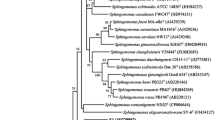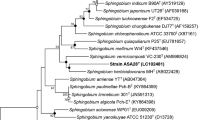Abstract
A phenazine-1-carboxylic acid (PCA)–degrading bacterium, strain DP58, was isolated from pimiento rhizosoil. Based on morphology, physiologic tests, 16S rDNA sequence, and phylogenetic characteristics, it was identified as Sphingomonas sp. The PCA-degradation experiments were conducted both in Luria-Bertani and inorganic salt medium at 28°C. The relationship between bacterium growth and PCA degradation suggested that strain DP58 could use PCA as the sole source of carbon and nitrogen and was able to completely degrade PCA in 40 hours. Newly isolated strain DP58 represents the first bacterium that can degrade PCA.





Similar content being viewed by others
Literature Cited
Dauguis AJ, McCraken CM (2003) Microbial degradation of high and low molecular weight polyaromatic hydrocarbons in a two-phase partitioning bioreactor by two strains of Sphingomonas sp. Biotechnol Lett 25:1441–1444
Ausubel FM, Brent R, Kingston RE, Moore DD, Seidman JG, Smith JA, et al. (eds) (1995) Short protocols in molecular biology. New York, NY: Wiley
Britigan BE, Rasmussen GT, Cox CD (1997) Augmentation of oxidant injury to human pulmonary epithelial cells by the Pseudomonas aeruginosa siderophore pyochelin. Infect Immun 65:1071–1076
Dong XZ, Cai MY (2001) Manual of identification for general bacteriology. Bei**g, China: Publishing Company of Science, pp 353–364
Ge YH, Huang XQ, Wang SL, Zhang XH, Xu YQ (2004) Pyoluteorin is positively regulated and phenazine-1-carboxylic acid negatively regulated by gacA in Pseudomonas sp. M-18. FEMS Microbiol Lett 237:39–45
Hassan HM, Fridovich I (1980) Mechanism of the antibiotic action of pyocyanine. J Bacteriol 141:156–163
Haas D, Keel C (2003) Regulation of antibiotic production in root-colonizing Pseudomonas spp. and relevance for biological control of plant disease Annu Rev Phytopathol 41:117–153
Herigstad B, Hamilton M, Heersink J (2001) How to optimize the drop plate method for enumerating bacteria. J Microbiol Methods 44:121–129
Hu HB, Xu YQ, Cheng F, Zhang XH, Hur B (2005) Isolation and characterization of a new Pseudomonas strain produced both phenazine 1-carboxylic acid and pyoluteorin. J Microbiol Biotech 15:86–90
Janikowski TB, Velicogna D, Punt M, Daugulis AJ (2002) Use of a two-phase partitioning bioreactor for degrading polycyclic aromatic hydrocarbons by a Sphingomonas sp. Appl Microbiol Biotechnol 59:368–376
Nishimori E, Kita-Tsukamoto K, Akabayashi HW (2000) Pseudomonas plecoglossicida sp. nov., the causative agent of bacterial haemorrhagic ascites of ayu, Plecoglossus altivelis. Int J Syst Evol Microbiol 50:83–89
Saitou N, Nei M (1987) The neighbor-joining method: A new method for reconstructing phylogenetic trees. Mol Biol Evol 4:406–425
Sasaki M, Maki J, Oshiman K, Matsumura Y, Tsuchido T (2005) Biodegradation of bisphenol A by cells and cell lysate from Sphingomonas sp. strain AO1. Biodegradation 16:449–459
Senoo K, Nishiyama M, Matsumoto S (1996) Bioremediation of gamma-HCH-polluted field soil by inoculation with an aerobic gamma-HCH-decomposing bacterium (Sphingomonas paucimobilis SS86). Soil Sci Plant Nutr 42:11–19
Shaukat SS, Siddiqui IA (2003) The influence of mineral and carbon source on biologic control of charcoal rot fungus, Macrophomina phaseolina, by fluorescent pseudomonads in tomato. Lett Appl Microbiol 36:392–398
Sørensen SR, Ronen Z, Aamand J (2001) Isolation from agricultural soil and characterization of a Sphingomonas sp. able to mineralize the phenylurea herbicide Isoproturon. Appl Environ Microbiol 67:5403–5409
Tabata K, Kasuya KI, Abe H, Masuda K, Doi Y (1999) Poly(aspartic acid) degradation by a Sphingomonas sp. isolated from freshwater. Appl Environ Microbiol 65:4268–4270
Thompson JD, Higgins DG, Gibson TJ (1994) CLUSTAL W: Improving the sensitivity of progressive multiple sequence alignment through sequence weighting, position specific gap penalties and weight matrix choice. Nucleic Acids Res 22:4673–4680
Tirola MA, Männistö MK, Puhakka JA, Kulomaa MS (2002) Isolation and characterization of Novosphingobium sp. strain MT1, a dominant polychlorophenol degrading strain in a groundwater bioremediation system. Appl Environ Microbiol 68:173–180
Weisburg WG, Barns SM, Pelletier DA, Lane DJ (1991) 16S ribosomal DNA amplification for phylogenetic study. J Bacteriol 173:697–703
Wittmann C, Zeng AP, Deckwer WD (1998) Physiological characterization and cultivation strategies of the pentachlorophenol-degrading bacteria Sphingomonas chlorophenolica RA2 and Mycobacterium chlorophenolicum PCP-1. J Ind Microbiol Biotechnol 21:315–321
**a Y, Min H, Rao G (2005) Isolation and characterization of phenanthrene-degrading Sphingomonas paucimobilis strain ZX4. Biodegradation 16:393–402
Yabuuchi E, Yano I, Oyaizu H, Hashimoto Y, Ezaki T, Yamamoto H (1990) Proposals of Sphingomonas paucimobilis gen. nov. and comb. nov., Sphingomonas parapaucimobilis sp. nov., Sphingomonas yanoikuyae sp. nov., Sphingomonas adhaesiva sp. nov., Sphingomonas capsulata comb. nov., and two genospecies of the genus Sphingomonas. Microbiol Immunol 34:99–119
Yang ZJ, Hu HB, Zhang XH, Xu YQ (2007) Solubility of phenazine-1-carboxylic acid in water, methanol, and ethanol from (278.2 to 328.2) K. J Chem Eng Data 52:184–185
Acknowledgment
The authors thank the National Natural Science Foundation of China (No. 20406010) for financial support.
Author information
Authors and Affiliations
Corresponding author
Rights and permissions
About this article
Cite this article
Yang, ZJ., Wang, W., **, Y. et al. Isolation, Identification, and Degradation Characteristics of Phenazine-1-Carboxylic Acid–Degrading Strain Sphingomonas sp. DP58. Curr Microbiol 55, 284–287 (2007). https://doi.org/10.1007/s00284-006-0522-7
Received:
Accepted:
Published:
Issue Date:
DOI: https://doi.org/10.1007/s00284-006-0522-7




